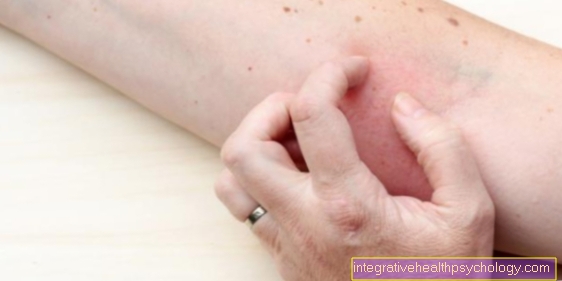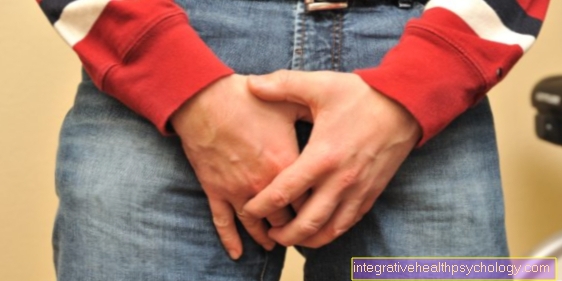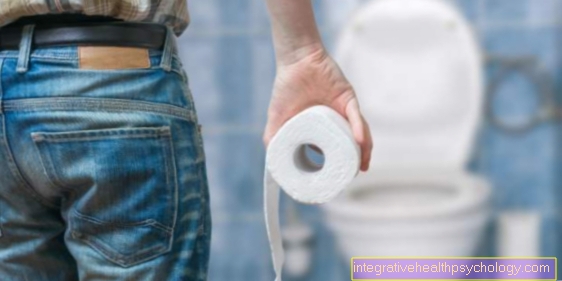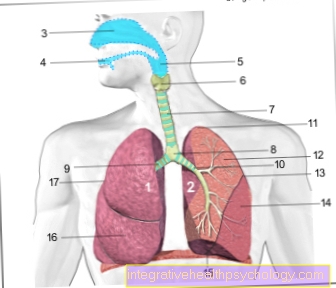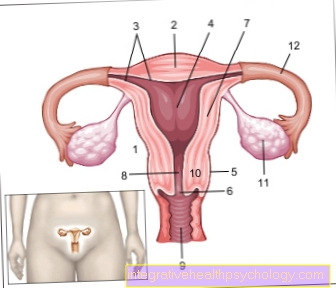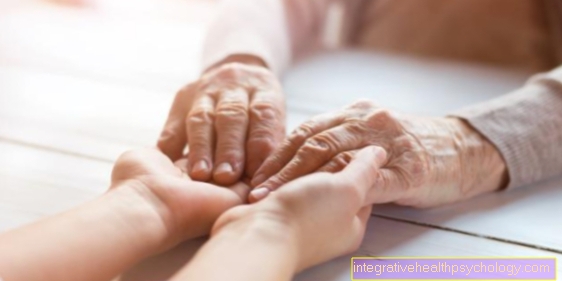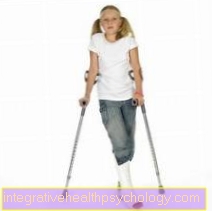Post-operative care
introduction
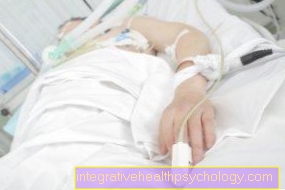
Postoperative care is the care of a patient according to (lat: post Office) called the OP. It begins immediately after the operation in the so-called recovery room and is then continued on the respective ward or at home.
The duration and extent of care are extremely variable and are strongly influenced by the severity of the operation but also by the general condition of the patient. In this way, healthy, fit patients will recover more quickly from the same procedure than patients with many underlying diseases, whose resources are already being used up by these diseases.
In the hospital
In the hospital, postoperative care begins immediately after the operation in the recovery room, which in most cases is directly connected to the operating room. A patient usually stays there for a few hours before he can be brought back to the ward. Care at this time focuses on monitoring the patient's signs of life and so blood pressure, heart rate and breathing are monitored as standard and the nurses take care of the necessary infusions and medication, especially painkillers for postoperative pain or give oxygen, if necessary the affected person feels shortness of breath. If the condition worsens, it is important that the postoperative care team knows the special emergency measures and initiates them in good time. The staff in the recovery room is usually very well prepared for such emergencies. The post-operative care teams in the recovery room also take care of nausea and vomiting, which often occurs after anesthesia, and ensure that urine bottles are disposed of.
You might also be interested in: Pain after surgery
Furthermore, it is important in postoperative care to know different positions or to carry them out as directed by a doctor, because depending on the operation, certain postures may not be assumed by the patient and in the worst case they are extremely harmful. The needs of the patient must also be taken into account and the most comfortable and pain-free positioning for the patient should always be sought. These special features of patient positioning must be taken into account throughout postoperative care beyond the recovery room. The purpose and almost the most important task of postoperative care in the recovery room, in addition to recovery from anesthesia and surgery and general care, is the early recognition of complications. The main thing here is to detect early blood loss due to secondary bleeding. The main focus here is on the observation of drains and catheters, bandages or other physical signs.
After the time has elapsed, the patient is transferred to his ward or, if the condition deteriorates, to one Intensive care unit brought. Depending on the patient's condition and the doctor's instructions, the newly operated patient may also leave the bed for the first time, but usually only in the presence of nursing staff at the beginning. In matters personal hygiene the nursing staff should offer oral care and wash the patient in order to increase his well-being and to encourage independence again. In most cases, this is the case when washing Operating area left out. Dressing and changing should be supported, whereby the pain and stress limits of the patient shortly after an operation must always be observed. In bedridden patients, e.g. After very serious operations, the so-called Pressure ulcer, a withering away skin and Subcutaneous tissue if the load is too long, can be prevented.
The most common places here are Heels or the buttocks, if they are under constant stress while lying down and the patient does not move. Regular changes of position can prevent the development of a pressure ulcer. Furthermore, patients with little intrinsic movement, e.g. in the coma, often endangers one thrombosis and must be treated with special medication and the legs examined for possible thromboses. in the Oral cavity forms quickly when there is no food intake Fungal attack off or can Stomach contents by the lying position in the lung advised and one lung infection trigger.
Quality Oral care the nursing staff can often prevent the fungal attack. Due to the lying position and the lack of movement, the Bowel movement get out of balance quickly and it comes to a total Bowel arrest With constipation (lat: Constipation). Drink a lot, Massages or enemas and other medication must then stimulate the bowel movements again. To the state of Gastrointestinal tract Keeping a close eye on things plays a role in postoperative care Accounting a role. This describes the exact documentation about bowel movement (Time, consistency, smell ...), possible vomiting, drinking and urine quantities.
In order to ensure the early detection of complications such as secondary bleeding, observation from the recovery room is continued in postoperative care and the drainage content and bandages are regularly checked. Since pain does not only occur immediately after the operation, the continuation of pain control is another component that runs through the entire postoperative care.
Patients in need of care at home

The nursing staff should give the patient information and instructions on what to observe at home, preferably in writing. If a nursing service is necessary, this can be organized with the help of the hospital's social services. Any aids that may become necessary, such as a care bed, rollator, night chair, walking aids, etc. can also be procured from medical supply stores. The procurement of these aids and the search for a suitable nursing service should start at an early stage so that everything is ready for life at home when the patient is discharged. Similar conditions apply at home as for post-operative care in the hospital. In the event of warning signs such as fever, a doctor should be contacted urgently, as the conditions after an operation can easily cause germs to get into the body, be it through the operation itself but also through postoperative problems such as long-term ventilation, urinary catheters or pneumonia.
They all cause a fever and must be treated with antibiotics in a short time. The first steps taken by the caregiver are leg compresses, cold drinks or cooling ablutions. Just like the nurses in postoperative care in the hospital, the patients themselves, their relatives and the nurses must also pay attention to bowel movements and urinary behavior in order to be aware of bowel or kidney dysfunction at an early stage. The storage must be carried out in a similar way to that in a hospital, although this should be handed over to a nursing service in difficult cases.
If the relatives or the patient themselves notice signs of a complication of the wound or bleeding, for example if the drain is unusually full, the bandage is perfused or dizziness and paleness occur, a doctor should be consulted immediately. The wound control and dressing change must also be continued strictly according to the specifications in order to be able to treat possible wound healing disorders or inflammations in good time. Since the entire care is a complex topic, especially after major operations, the temporary use of a care service should be considered very generously, as it is associated with considerable effort for relatives alone and brings them to their limits very quickly.
Non-dependent patients at home
What to do at home after an operation depends heavily on the procedure. Nevertheless, there are some general basic rules for personal hygiene or even the Wound care to be observed. Instructions on behavior are often provided by the wards in written form as information sheets for the patients and these are also explained directly by the nursing staff or doctors. Personal hygiene can usually be resumed in the hospital, depending on mobility. Only showering or bathing usually has to be avoided for a few days or weeks. After minor operations, showering is usually allowed again after a few days, major operations require a waiver for several weeks and are dependent on the success of the wound healing.
Partial washes leaving out the operating area are usually always possible. When a bandage can be removed and how often it has to be changed is usually strictly specified by the doctor. When changing the dressing, the wound should always be examined briefly. Should pus occur or the wound be extremely red, swollen and sensitive to pain, this can be an indication of germs that have entered and a doctor should be consulted. When the sutures are pulled varies greatly depending on the physical region, the time is usually given by the doctor. In order to promote the aesthetically beautiful scar formation, in order to later be as inconspicuous as possible and not discolored scar Direct sunlight on the scar should be avoided for 3-6 months. If an affected person takes medication regularly, a doctor should discuss when they should be taken again if they have been discontinued during the operation period. So special caution applies to this blood thinning Medication, as this can promote bleeding.







